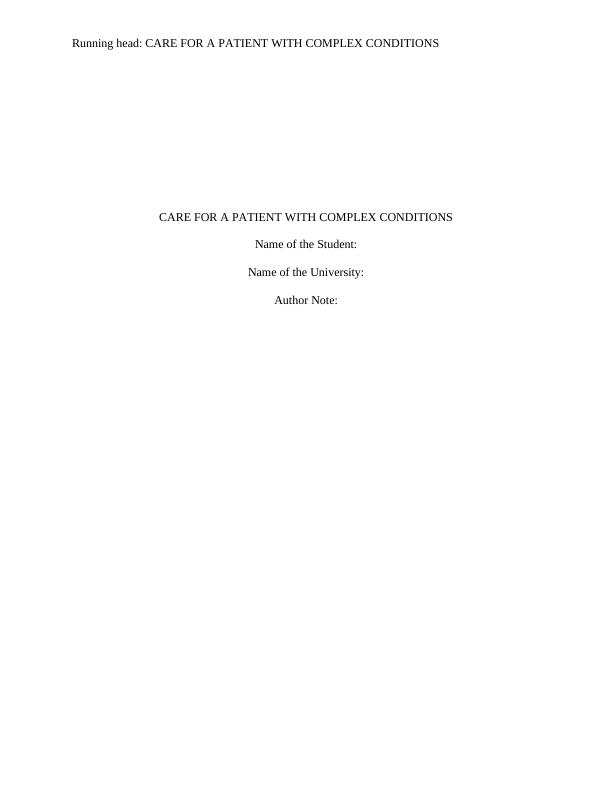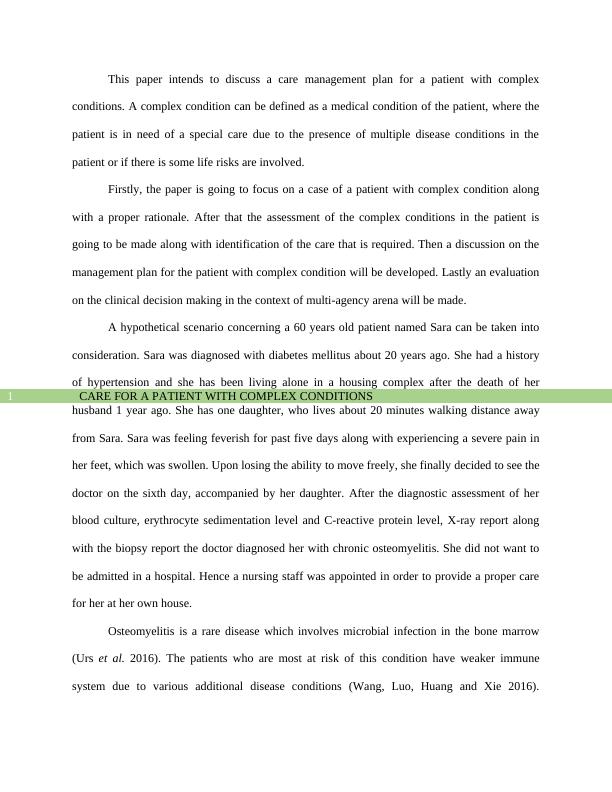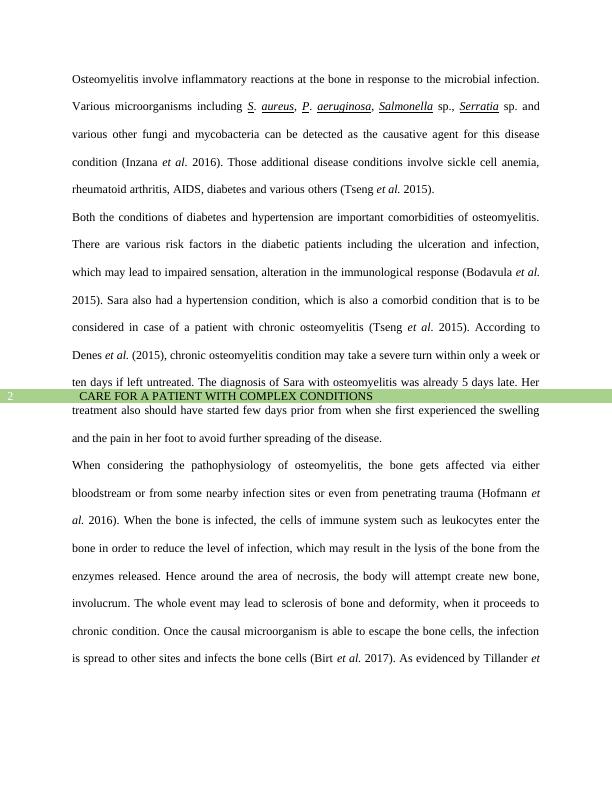Journal of Medical Sciences
Added on 2022-08-23
16 Pages5353 Words24 Views
Running head: CARE FOR A PATIENT WITH COMPLEX CONDITIONS
CARE FOR A PATIENT WITH COMPLEX CONDITIONS
Name of the Student:
Name of the University:
Author Note:
CARE FOR A PATIENT WITH COMPLEX CONDITIONS
Name of the Student:
Name of the University:
Author Note:

CARE FOR A PATIENT WITH COMPLEX CONDITIONS1
This paper intends to discuss a care management plan for a patient with complex
conditions. A complex condition can be defined as a medical condition of the patient, where the
patient is in need of a special care due to the presence of multiple disease conditions in the
patient or if there is some life risks are involved.
Firstly, the paper is going to focus on a case of a patient with complex condition along
with a proper rationale. After that the assessment of the complex conditions in the patient is
going to be made along with identification of the care that is required. Then a discussion on the
management plan for the patient with complex condition will be developed. Lastly an evaluation
on the clinical decision making in the context of multi-agency arena will be made.
A hypothetical scenario concerning a 60 years old patient named Sara can be taken into
consideration. Sara was diagnosed with diabetes mellitus about 20 years ago. She had a history
of hypertension and she has been living alone in a housing complex after the death of her
husband 1 year ago. She has one daughter, who lives about 20 minutes walking distance away
from Sara. Sara was feeling feverish for past five days along with experiencing a severe pain in
her feet, which was swollen. Upon losing the ability to move freely, she finally decided to see the
doctor on the sixth day, accompanied by her daughter. After the diagnostic assessment of her
blood culture, erythrocyte sedimentation level and C-reactive protein level, X-ray report along
with the biopsy report the doctor diagnosed her with chronic osteomyelitis. She did not want to
be admitted in a hospital. Hence a nursing staff was appointed in order to provide a proper care
for her at her own house.
Osteomyelitis is a rare disease which involves microbial infection in the bone marrow
(Urs et al. 2016). The patients who are most at risk of this condition have weaker immune
system due to various additional disease conditions (Wang, Luo, Huang and Xie 2016).
This paper intends to discuss a care management plan for a patient with complex
conditions. A complex condition can be defined as a medical condition of the patient, where the
patient is in need of a special care due to the presence of multiple disease conditions in the
patient or if there is some life risks are involved.
Firstly, the paper is going to focus on a case of a patient with complex condition along
with a proper rationale. After that the assessment of the complex conditions in the patient is
going to be made along with identification of the care that is required. Then a discussion on the
management plan for the patient with complex condition will be developed. Lastly an evaluation
on the clinical decision making in the context of multi-agency arena will be made.
A hypothetical scenario concerning a 60 years old patient named Sara can be taken into
consideration. Sara was diagnosed with diabetes mellitus about 20 years ago. She had a history
of hypertension and she has been living alone in a housing complex after the death of her
husband 1 year ago. She has one daughter, who lives about 20 minutes walking distance away
from Sara. Sara was feeling feverish for past five days along with experiencing a severe pain in
her feet, which was swollen. Upon losing the ability to move freely, she finally decided to see the
doctor on the sixth day, accompanied by her daughter. After the diagnostic assessment of her
blood culture, erythrocyte sedimentation level and C-reactive protein level, X-ray report along
with the biopsy report the doctor diagnosed her with chronic osteomyelitis. She did not want to
be admitted in a hospital. Hence a nursing staff was appointed in order to provide a proper care
for her at her own house.
Osteomyelitis is a rare disease which involves microbial infection in the bone marrow
(Urs et al. 2016). The patients who are most at risk of this condition have weaker immune
system due to various additional disease conditions (Wang, Luo, Huang and Xie 2016).

CARE FOR A PATIENT WITH COMPLEX CONDITIONS2
Osteomyelitis involve inflammatory reactions at the bone in response to the microbial infection.
Various microorganisms including S. aureus, P. aeruginosa, Salmonella sp., Serratia sp. and
various other fungi and mycobacteria can be detected as the causative agent for this disease
condition (Inzana et al. 2016). Those additional disease conditions involve sickle cell anemia,
rheumatoid arthritis, AIDS, diabetes and various others (Tseng et al. 2015).
Both the conditions of diabetes and hypertension are important comorbidities of osteomyelitis.
There are various risk factors in the diabetic patients including the ulceration and infection,
which may lead to impaired sensation, alteration in the immunological response (Bodavula et al.
2015). Sara also had a hypertension condition, which is also a comorbid condition that is to be
considered in case of a patient with chronic osteomyelitis (Tseng et al. 2015). According to
Denes et al. (2015), chronic osteomyelitis condition may take a severe turn within only a week or
ten days if left untreated. The diagnosis of Sara with osteomyelitis was already 5 days late. Her
treatment also should have started few days prior from when she first experienced the swelling
and the pain in her foot to avoid further spreading of the disease.
When considering the pathophysiology of osteomyelitis, the bone gets affected via either
bloodstream or from some nearby infection sites or even from penetrating trauma (Hofmann et
al. 2016). When the bone is infected, the cells of immune system such as leukocytes enter the
bone in order to reduce the level of infection, which may result in the lysis of the bone from the
enzymes released. Hence around the area of necrosis, the body will attempt create new bone,
involucrum. The whole event may lead to sclerosis of bone and deformity, when it proceeds to
chronic condition. Once the causal microorganism is able to escape the bone cells, the infection
is spread to other sites and infects the bone cells (Birt et al. 2017). As evidenced by Tillander et
Osteomyelitis involve inflammatory reactions at the bone in response to the microbial infection.
Various microorganisms including S. aureus, P. aeruginosa, Salmonella sp., Serratia sp. and
various other fungi and mycobacteria can be detected as the causative agent for this disease
condition (Inzana et al. 2016). Those additional disease conditions involve sickle cell anemia,
rheumatoid arthritis, AIDS, diabetes and various others (Tseng et al. 2015).
Both the conditions of diabetes and hypertension are important comorbidities of osteomyelitis.
There are various risk factors in the diabetic patients including the ulceration and infection,
which may lead to impaired sensation, alteration in the immunological response (Bodavula et al.
2015). Sara also had a hypertension condition, which is also a comorbid condition that is to be
considered in case of a patient with chronic osteomyelitis (Tseng et al. 2015). According to
Denes et al. (2015), chronic osteomyelitis condition may take a severe turn within only a week or
ten days if left untreated. The diagnosis of Sara with osteomyelitis was already 5 days late. Her
treatment also should have started few days prior from when she first experienced the swelling
and the pain in her foot to avoid further spreading of the disease.
When considering the pathophysiology of osteomyelitis, the bone gets affected via either
bloodstream or from some nearby infection sites or even from penetrating trauma (Hofmann et
al. 2016). When the bone is infected, the cells of immune system such as leukocytes enter the
bone in order to reduce the level of infection, which may result in the lysis of the bone from the
enzymes released. Hence around the area of necrosis, the body will attempt create new bone,
involucrum. The whole event may lead to sclerosis of bone and deformity, when it proceeds to
chronic condition. Once the causal microorganism is able to escape the bone cells, the infection
is spread to other sites and infects the bone cells (Birt et al. 2017). As evidenced by Tillander et

CARE FOR A PATIENT WITH COMPLEX CONDITIONS3
al. 2017, the condition becomes more complex and dangerous if the bacteria are found to be
antibiotic-resistant, which may increase the risks of disability and amputation.
The progression of osteomyelitis is most likely affect the mobility of the patient, which in
turn may affect her social life as well as her mental health due to the feeling of helplessness
(Abulaiti et al. 2017). Impaired mobility will result in her limited interaction with society which
in turn may result her isolation from the society. Limited interaction with society is often
associated with the feeling of loneliness (Ye and Lin 2015). Additionally since her negative
physical condition is the only thing that is restricting her from making the interaction, it may
cause the feelings of depression in the patient (Domènech-Abella et al. 2017).
Hence the condition of Sara can be considered as complex from her three health
conditions. Her old age along with hypertension and diabetic condition had already kept her
vulnerable with various symptoms associated with those two disease conditions. Additionally the
diabetes and hypertension are considered as important co-morbid conditions as there are
increased risks of heart disease, vascular complications and various other diseases that present
mortal risks to a patient (American Diabetes Association 2015).
In order to develop a care plan for Sara, few assessments are required to be made while
taking her various disease conditions into consideration. The most important and risky condition
that can be identified in Sara is the complications regarding osteomyelitis. The assessments must
be made in order to observe the progression of the disease by assessing the levels of pain the
patient is experiencing, the swelling in her foot along with the level of mobility in the patient.
The diabetes and hypertension also should be subjected to monitoring since they are
comorbidities that present the risks to the health and the well-being of the patient. The diabetes
can be assessed by the diabetes self-management questionnaire (DSMQ) tool in order to track the
al. 2017, the condition becomes more complex and dangerous if the bacteria are found to be
antibiotic-resistant, which may increase the risks of disability and amputation.
The progression of osteomyelitis is most likely affect the mobility of the patient, which in
turn may affect her social life as well as her mental health due to the feeling of helplessness
(Abulaiti et al. 2017). Impaired mobility will result in her limited interaction with society which
in turn may result her isolation from the society. Limited interaction with society is often
associated with the feeling of loneliness (Ye and Lin 2015). Additionally since her negative
physical condition is the only thing that is restricting her from making the interaction, it may
cause the feelings of depression in the patient (Domènech-Abella et al. 2017).
Hence the condition of Sara can be considered as complex from her three health
conditions. Her old age along with hypertension and diabetic condition had already kept her
vulnerable with various symptoms associated with those two disease conditions. Additionally the
diabetes and hypertension are considered as important co-morbid conditions as there are
increased risks of heart disease, vascular complications and various other diseases that present
mortal risks to a patient (American Diabetes Association 2015).
In order to develop a care plan for Sara, few assessments are required to be made while
taking her various disease conditions into consideration. The most important and risky condition
that can be identified in Sara is the complications regarding osteomyelitis. The assessments must
be made in order to observe the progression of the disease by assessing the levels of pain the
patient is experiencing, the swelling in her foot along with the level of mobility in the patient.
The diabetes and hypertension also should be subjected to monitoring since they are
comorbidities that present the risks to the health and the well-being of the patient. The diabetes
can be assessed by the diabetes self-management questionnaire (DSMQ) tool in order to track the

End of preview
Want to access all the pages? Upload your documents or become a member.
Related Documents
THE REFLECTIVE ESSAYlg...
|10
|3484
|37
Nursing Care Plan for Mrs. Mary: Complex Needs and Interventionslg...
|16
|4079
|160
Nursing Palliative Care for Patients - Importance of Multidisciplinary Teamlg...
|4
|799
|372
Palliative Care Practice Case Study 2022lg...
|8
|1793
|19
Nursing Case Study on Exogenous Cushing’s Syndromelg...
|10
|2522
|429
Care for a Person with Dementialg...
|13
|3579
|97
